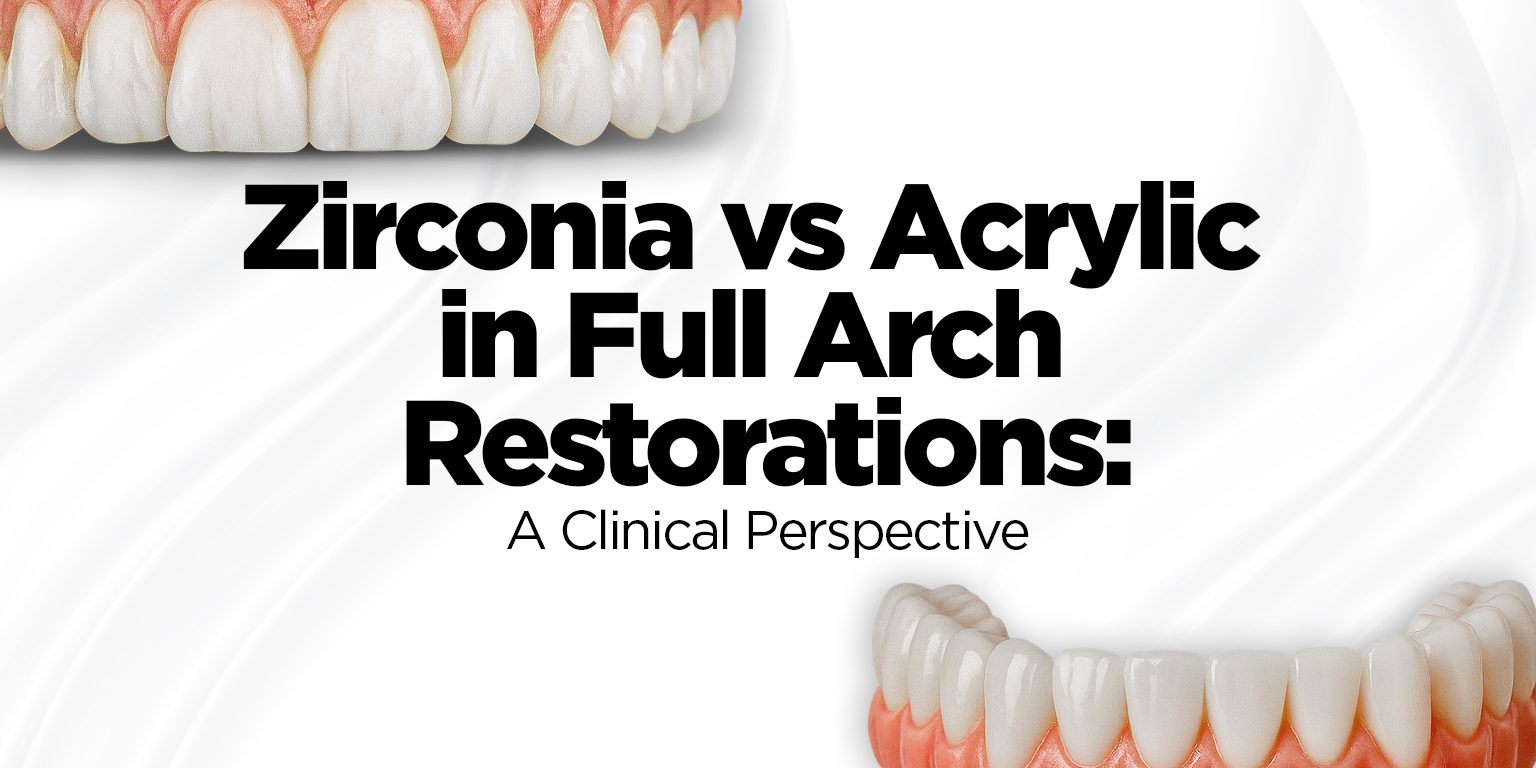Full Arch Zirconia vs. Acrylic Hybrids: What Dentists Need to Know
In the world of implant-supported prosthetics, one clinical decision can have lasting effects: selecting the right material for full-arch restorations. As digital dentistry evolves, so do the available options. One of the most common and critical comparisons today is zirconia vs acrylic full arch restorations.
This blog offers a clear, clinical implant prosthetic comparison to help dentists, prosthodontists, and implantologists choose the most suitable restoration based on long-term outcomes, patient expectations, and functional demands.
Zirconia vs Acrylic Full Arch: The Basics
Before diving into technical differences, it’s important to understand what these restorations are:
- Acrylic hybrids are typically constructed with a metal framework overlaid with acrylic resin and denture teeth. They are common in immediate load cases and known for their cost efficiency and adjustability.
- Zirconia restorations are fabricated from solid blocks of high-strength zirconia, either monolithic or layered for esthetics. These restorations are milled using CAD/CAM technology and offer long-term performance and biocompatibility.
While both materials have a place in full-arch prosthetics, each comes with distinct advantages and limitations that influence clinical outcomes.
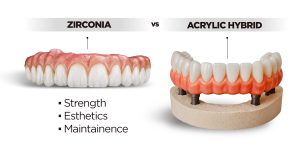
Durability & Strength
Acrylic Hybrids
Acrylic hybrids provide acceptable durability in the short term but are more prone to fractures, chipping, and wear—especially under heavy occlusal forces. While the underlying bar helps, the acrylic component itself is less resistant to long-term stress.
Zirconia
Zirconia is significantly stronger and more fracture-resistant. It can withstand high occlusal loads without the need for reinforcement. Monolithic designs in particular offer exceptional durability, making them ideal for patients with parafunctional habits or a strong bite.
Takeaway: In a zirconia vs acrylic full arch comparison, zirconia clearly leads in mechanical strength and long-term structural integrity.
Esthetics & Translucency
Acrylic Hybrids
Acrylic restorations can offer good esthetics when properly designed and colored. The use of denture teeth allows customization, but the material is prone to staining and wear over time.
Zirconia
High-translucency zirconia can mimic natural enamel with far better stain resistance. For patients who prioritize esthetics, especially in visible smile zones, zirconia offers a more natural and permanent solution. Layered zirconia designs can further enhance realism.
Takeaway: For patients seeking natural appearance and long-term esthetic stability, zirconia provides a superior outcome in this implant prosthetic comparison.
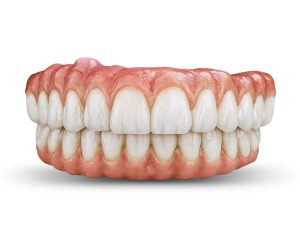
Maintenance & Longevity
Acrylic Hybrids
These restorations typically require more maintenance. Denture teeth may debond, wear, or fracture, and the acrylic base may absorb odors or discolor over time. Most need to be repaired or replaced after 5–7 years.
Zirconia
Zirconia is non-porous and more hygienic. It doesn’t stain, absorb odor, or chip easily. With proper planning and occlusion, full-arch zirconia restorations can last 10–15 years or more with minimal intervention.
Takeaway: In terms of maintenance, zirconia clearly outperforms acrylic. Fewer chairside repairs, fewer remakes, and easier hygiene for patients.
Workflow Considerations
Acrylic Hybrids
These are commonly used during immediate load protocols due to their fast fabrication and low cost. Clinicians often use them as a transitional restoration before delivering a definitive prosthesis.
Zirconia
Zirconia restorations require precise planning, verification of implant positions, and more detailed CAD/CAM workflows. While the lab time is longer, the end result is a long-term prosthesis that often eliminates the need for multiple provisional phases.
Takeaway: Acrylic is efficient for immediate delivery. Zirconia requires more planning but eliminates the need for repeated restorations over time.
Patient-Centered Factors
Choosing between zirconia and acrylic isn’t just about materials—it’s about the patient.
Acrylic May Be Best For:
- Budget-conscious patients
- Older patients with low occlusal force
- Cases requiring fast delivery or same-day loading
- Temporary or transitional prosthetics
Zirconia May Be Best For:
- Patients with high esthetic demands
- Younger patients seeking long-term results
- Bruxers or heavy biters
- Patients with excellent hygiene compliance
The right material should be aligned with patient lifestyle, medical history, and long-term expectations.
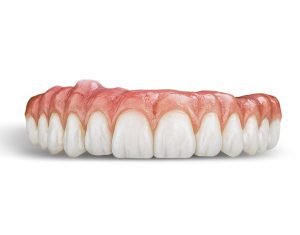
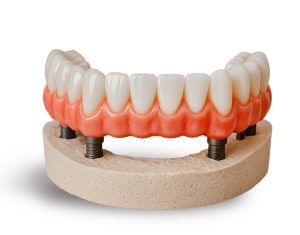
Cost and Value Over Time
While zirconia has a higher initial cost, the long-term value can be greater due to its longevity and reduced need for maintenance. Acrylic may appear more economical at first, but repeated repairs or eventual replacement often increase the total cost over time.
Implant prosthetic comparison shows:
- Acrylic hybrids cost less up front but may require frequent maintenance or replacement.
- Zirconia has a higher initial price but often eliminates future lab costs.
Final Thoughts: Zirconia vs Acrylic Full Arch
When comparing zirconia vs acrylic full arch restorations, both materials offer viable solutions. The key is knowing when to use each. Acrylic hybrids play an important role in immediate load protocols and provisionalization, while zirconia is ideal for final, high-performance prosthetics.
As implant dentistry continues to evolve toward fully digital workflows, zirconia remains the material of choice for clinicians who value precision, esthetics, and long-term predictability.
Ready to Order Your Final Zirconia Restoration?
At 3DDX, we specialize in digital workflows for full-arch zirconia restorations, from planning to final delivery. Our lab-crafted prosthetics are designed for durability, esthetics, and long-term function.
Submit your case today and experience the difference in precision and patient satisfaction.

 Support
Support FINE-TUNE
FINE-TUNE ORDER SERVICES
ORDER SERVICES PRODUCT SHOP
PRODUCT SHOP 1-866-834-7925
1-866-834-7925